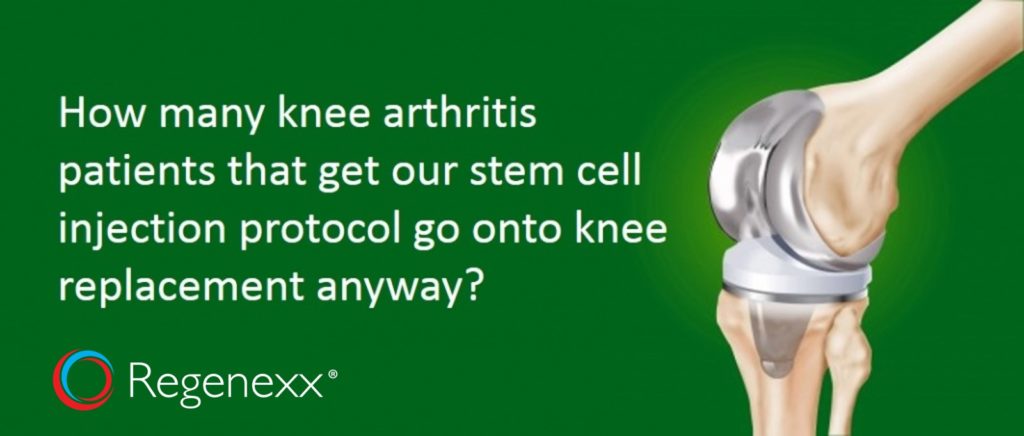How Many Stem Cell Patients Convert to Knee Replacement?
Most of the patients we see who want stem cell injections have been told that they need or will soon require a knee replacement. As a result, we’ve tracked knee replacement rates, after a precise injection of stem cells in our registry. So what percentage of Regenexx-SD stem cell patients convert to knee replacement after treatment and what does that number actually mean?
As part of our #SatStats questions, I asked patients to guess the percentage of patients who went on to knee replacement despite a Regenexx-SD procedure. What was that number? Tracking 1,108 treated knee arthritis patients across the country for an average of 17 months (1 month up to 4+ years), only 1.62% of patients reported to us that they had a knee replacement. First, it’s important to put this in context. Since this is a treatment registry, we have patients who despite our best efforts of e-mail, calls, and prizes; who don’t respond. Hence, the actual rate is likely higher than this number. However, if we take the number of patients who never respond and assume that they had the same knee replacement rate as those who did, then we would be left with a number around 3-4%. This is a pretty good assumption, as prior pushes to get all of our patients to respond have resulted in no difference in the outcome of these patients when compared to those that do respond. However, just to be ridiculously careful, let’s say that’s also wrong, that for some reason, when it comes to this metric there are more knee replacements in the non-response group. So for arguments sake, let’s triple the rate of knee replacements in the non-responder group. This then puts the rate of knee replacements in the 7-8% range.
Using our inflated number, we can now get some sense of the impact we may have had on these patients’s lives by helping them avoid knee replacement. In prior studies when we’ve looked at the number of knee replacement candidates at time of treatment, it’s been about 2/3rds. So if we use the higher estimated knee replacement number and elevate it by 1/3, we’re left with about 11% of those who needed a knee replacement at the start and who got one anyway. Since we started with 1,108 patients, this means that about 730 are in our eminent knee replacement group. From prior studies we’ve published, we know the risks of serious complications from knee replacement. So if all of these patients had decided on surgery instead of stem cells, this is what the complications would have looked like (low to high estimates):
1. 57-73 patients with serious surgical complications
2. 4-31 patients with a hospital readmission for serious infection requiring IV antibiotics because of an infection
3. 2-4 deaths
So in the knee replacement vs stem cells equation, how did our stem cell treated group fare? Almost none of these complications were seen and certainly no deaths due to the procedure.
The upshot? The rate of patients who get a knee replacement despite our very specific protocol of same day stem cell injections is low, even if we use worst case scenarios. Forgetting about knee stem cell treatment outcomes (which we’ve extensively published), if we just focus on the reduction of serious complications, we’ve likely helped many patients avoid some of the life changing side effects of knee replacement surgery.

If you have questions or comments about this blog post, please email us at [email protected]
NOTE: This blog post provides general information to help the reader better understand regenerative medicine, musculoskeletal health, and related subjects. All content provided in this blog, website, or any linked materials, including text, graphics, images, patient profiles, outcomes, and information, are not intended and should not be considered or used as a substitute for medical advice, diagnosis, or treatment. Please always consult with a professional and certified healthcare provider to discuss if a treatment is right for you.

